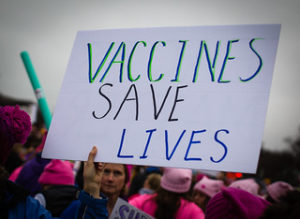
Concern about vaccine hesitancy has grown dramatically in the last few years, with the World Health Organization flagging it as a top global health threat. This is hardly surprising given worldwide outbreaks of measles and other vaccine-preventable diseases.
Misinformation relating to vaccines is widespread on social media; a recent survey found half of parents with young children were exposed to negative messages about vaccination in this environment.
The hazard of misinformation is its potential to decrease public confidence in vaccines. The challenge is knowing when and how to address vaccine misinformation without accidentally amplifying it.
To address these questions, we asked experts how they manage vaccine misinformation on social media. We published our findings in BMC Public Health this month.
Vaccine-promoting organizations are well-placed to address misinformation
We developed our research around the notion that vaccine-promoting organizations are in a favorable position to address misinformation. Unlike traditional media, social media platforms offer these organizations a direct line of communication with parents and other people making decisions about vaccinations.
Thus, investigating their perspectives and strategies is an important means of supporting efforts to deal with vaccine misinformation.
We set out to gather insights by interviewing people responsible for day-to-day social media activity and strategy in vaccine-promoting organizations in Australia. We targeted organizations active on Facebook, the dominant social media platform in Australia, and Twitter, known for hosting debates around health issues.
In total, we interviewed 21 participants from 17 organizations.
Trust in vaccines is perceived as under threat
 Our participants described vaccination as divisive on social media, with polarized dialogue and hostile interactions being commonplace.
Our participants described vaccination as divisive on social media, with polarized dialogue and hostile interactions being commonplace.
Their main audience was parents making decisions about vaccination. They recognized that this audience extended beyond those people openly participating on social media.
Some speculated that this silent audience—users who are listening but not responding in any visible way—may have comments or questions about vaccines but avoid discussing them in public because they are worried about being attacked.
They identified multiple threats to their audience’s trust in vaccination in this environment. At the top of their list was the pervasiveness of misinformation. Anti-vaccine activists were also characterized as a threat because of their perceived persuasiveness and use of assertive tactics such as prolific posting of misinformation.
Participants spoke of an anti-science sentiment among some users of social media. The complexity of the vaccine narrative posed further difficulties; it could be challenging to discuss adverse events, for example, without alarming audiences or appearing to gloss over risks.
Organizations use a sophisticated array of strategies
Our participants asserted that amplifying the pro-vaccine voice—by building their online presence and boosting the visibility of like-minded organizations—was necessary to counterbalance misinformation and the voice of activists on social media.
They used a sophisticated array of strategies to promote vaccines. Sharing scientific evidence and facts was their primary tactic. Many attempted to create safe spaces where their audience could ask questions without fear of harassment from both pro-vaccine and anti-vaccine activists.
Curbing the influence of misinformation was also key. Our participants emphasized the importance of being concise and respectful when responding to posts containing misinformation.
Many opted to ignore, delete, or hide offending posts. This was to avoid being drawn into unproductive arguments and avoid amplifying misinformation.
Our recommendations for responding to misinformation on social media
 Based on our findings, we have made recommendations to vaccine-promoting organizations to help them respond to misinformation on social media.
Based on our findings, we have made recommendations to vaccine-promoting organizations to help them respond to misinformation on social media.
- When countering misinformation, avoid explicitly repeating the misinformation—this may inadvertently strengthen it in the audience’s memory. Emphasize the correct information instead.
- Offer information and answer questions in an honest and forthcoming way. Acknowledge risks. This can help decrease perceptions of risk and build trust, which is key when engaging with people who lack confidence in vaccination.
- While conveying facts is important, be cautious about overloading audiences with complex information. Complexity can reinforce misinformation, especially if the inaccurate narrative is simple and compelling. Try to offer audiences information that is straightforward and accessible.
- While it can be tempting to combat misinformation with facts, facts may not be enough. Offering non-judgemental support can also be valuable, as can story-telling and anecdotes about positive experiences of vaccination.
- Avoid antagonistic exchanges with anti-vaccine activists. Public arguments may send the erroneous signal that the value of vaccination is in dispute, when it is not. Keep interactions with anti-vaccine activists brief, factual and polite.
- Bear in mind that not all negative comments come from anti-vaccine activists. Hesitant parents can have real questions about safety. Labeling them anti-vaccine risks losing trust with this important audience.
- Finally, be aware of opportunities to influence the silent audience. It may be less resource-intensive to delete or hide offending posts rather than engage with misinformation on social media. However, when done in light of the suggestions above, responding to misinformation may influence silent audiences.
When dealing with vaccine misinformation on social media, organizations need to balance the potential benefits of directly responding with the risks and the amount of effort required.
We suggest reserving resources for when misinformation has spread beyond its source community. Having a well-defined indicator for the reach of a social media post, link, or comment could be an appropriate way of deciding when to act.
Comments